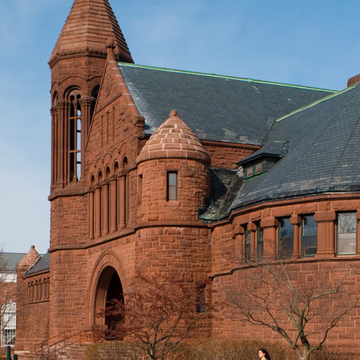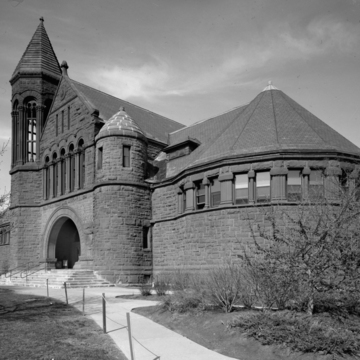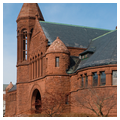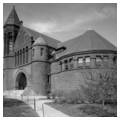You are here
Billings Student Center
This, Richardson's only work in Vermont and a renowned building in Burlington, was the university library until 1961. It was named for Frederick Billings, class of 1844 and president of the Northern Pacific Railroad, who retired to his hometown of Woodstock to an estate that had belonged to the family of George Perkins Marsh. Billings acquired Marsh's twelve-thousand-volume library as a gift for the university and supplied the funds to erect a building to house the collection in an appropriate fashion.
An involved patron, Billings personally selected Richardson, hoping to emulate the architect's Winn Library in Woburn, Massachusetts (1876–1879). The final design in Burlington is a cross between the picturesque animation of Woburn, with its bold gable and appended polygonal museum, and the more resolved unity of the architect's Crane Library in Quincy, Massachusetts (1880–1882). Its functional arrangement is clearly readable in its axially aligned massing—the main reading room in the gabled center section, the polygonal Marsh Collection room to the south, and the stack area to the north. Entrance is via a weighty Syrian arch set within a panel of richly patterned stonework similar to that Richardson used on Harvard's Austin Hall (1881–1884). Budgeting forced some adjustments to Richardson's original proposal, including the substitution of slate for tiles, pine for oak, and the shortening of the stack wing by one bay. Due to Billings's impatience, Norcross Brothers began work on the library's Longmeadow stone fabric in September 1883, before the details of the upper facade had been finalized, and the dedication occurred a year before the stone carving was completed. Still, at the time of the dedication Richardson declared it “the best thing I have yet done.”
The library had a significant impact on Burlington as local architects drew upon Richardson's Romanesque vocabulary. Its stone carver Alexander Milne returned to town to work on the details of at least one more building, Cathedral High School (1917; demolished). Norcross wood carver Albert H. Whittekind, who executed the great fireplace in the reading room and the carved hammer beams of the original Marsh Room, settled in Winooski, providing, until his death in 1943, rich interior and exterior carving for fine Burlington-area houses, public buildings, and churches.
No sooner was the library finished than Richardson's office was at work on modifications. An 1887 extension of the stack wing with a hipped north end and the 1889 east wing intended to house a relocated Marsh Collection were completed after Richardson's death in 1886 by his successor firm, Shepley, Rutan and Coolidge. After the opening of the much larger Bailey Library in 1961, Billings was converted for use as a student center, a function enhanced by a sympathetic 1984 expansion that connected it to the neighboring Ira Allen Chapel. This addition was completed by Shepley, Bulfinch, Richardson and Abbott, a contemporary Richardson successor.
Writing Credits
If SAH Archipedia has been useful to you, please consider supporting it.
SAH Archipedia tells the story of the United States through its buildings, landscapes, and cities. This freely available resource empowers the public with authoritative knowledge that deepens their understanding and appreciation of the built environment. But the Society of Architectural Historians, which created SAH Archipedia with University of Virginia Press, needs your support to maintain the high-caliber research, writing, photography, cartography, editing, design, and programming that make SAH Archipedia a trusted online resource available to all who value the history of place, heritage tourism, and learning.


















